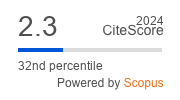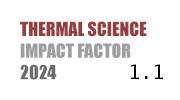THERMAL SCIENCE
International Scientific Journal
DEEP LEARNING TECHNOLOGY FOR FACE RECOGNITION
ABSTRACT
In China, the rapid development of public transportation network construction has been accompanied by a high incidence of traffic accidents caused by sleep-deprived driving. The monitoring of drivers' sleep-deprived driving and the sending out of early warnings has been identified as a field of research with both important theoretical and practical value. This article proposes a fatigue detection algorithm based on facial recognition information fusion. The algorithm extracts facial feature information and head features from the driver's face and fuses them into facial recognition information parameter feature vectors. A set of feature nodes is thus constructed, and an information fusion feature map is constructed according to the interaction information between nodes. The fatigue status is detected using the label propagation strategy, which is more effective than other benchmark detection algorithms. The fatigue detection algorithm has practical value.
KEYWORDS
PAPER SUBMITTED: 2023-11-23
PAPER REVISED: 2024-05-11
PAPER ACCEPTED: 2024-05-12
PUBLISHED ONLINE: 2025-07-06
THERMAL SCIENCE YEAR
2025, VOLUME
29, ISSUE
Issue 3, PAGES [2007 - 2014]
- Shahrndin, N. S. N., Sidek, K. A., A Review of ECG Data Acquisition for Driver Drowsiness Detection, Compusoft, 9 (2020), 7, pp. 3749-3754
- Girvan, M., Newman, M. E. J., Community Structure in Social and Biological Networks, Proceedings of the National Academy of Sciences, 99 (2002), 12, pp. 7821-7826
- Mott, G. E., et al., Efficient Driver Drowsiness Detection at Moderate Levels of Drowsiness, Accident Analysis and Prevention, 50 (2013), 1, pp. 341-350
- Li, Z. J., et al., Online Detection of Driver Fatigue Using Steering Wheel Angles for Real Driving Conditions, Sensors, 17 (2017), 3, pp. 495-507
- Wang, W., et al., A Survey of Zero-Shot Learning: Settings, Methods, and Applications, ACM Transactions on Intelligent Systems and Technology, 10 (2019), 2, pp. 1-37
- Furugori, S., et al., Estimation of Driver Fatigue by Pressure Distribution on Seat in Long Term Driving, Review of Automotive Engineering, 26 (2005), 1, pp. 53-58
- Wei, Y., et al., Multi-Vehicle Detection Algorithm through Combining Harr and Hog Features, Mathematics and Computers in Simulation, 79 (2019), 8, pp. 130-145
- Bila, C., et al., Vehicles of the Future: a Survey of Research on Safety Issues, IEEE Transactions on Intelligent Transportation Systems, 18 (2017), 5, pp. 1046-1065
- Mandal, B., et al., Towards Detection of Bus Driver Fatigue Based on Robust Visual Analysis of Eye State, IEEE Transactions on Intelligent Transportation Systems, 18 (2017), 3, pp. 545-557
- Nie, B. S., et al., Experimental Study on Visual Detection for Fatigue of Fixed-Position Staff, Applied Ergonomics, 65 (2017), Nov., pp. 1-11
- Yao, S., et al., Eye State Detection Method Based on LBP, Application Research of Computers, 32 (2015), 6, pp. 1897-1900
- Li, M., et al., Structure-Revealing Low-Light Image Enhancement via Robust Retinex Model, IEEE Transactions on Image Processing, 27 (2018), 6, pp. 2828-2841
- LeCun Y, et al., Deep Learning, Nature, 521 (2015), 7553, pp. 436-444
- Fu, X., et al., A Probabilistic Method for Image Enhancement with Simultaneous Illumination and Reflectance Estimation, IEEE Transactions on Image Processing, 24 (2015), 12, pp. 4965-4977
- Di, W., et al., Driver Eye Feature Extraction Based on Infrared illuminator, Journal of Transport Information & Safety, 27 (2009), 1, pp. 79-82
- Chen, X., et al., Vehicle Detection in Satellite Images by Hybrid Deep Convolutional Neural Networks, IEEE Geoscience and Remote Sensing Letters, 11 (2014), 10, pp. 1797-1801
- Gu, J., et al., Recent Advances in Convolutional Neural Networks, Pattern Recognition, 77 (2018), 12, pp. 1620-1634
- Zhang, K., et al., Joint Face Detection and Alignment Using Multitask Cascaded Convolutional Networks, IEEE Signal Processing Letters, 23 (2016), 10, pp. 1499-1503
- Song, F., et al., Eyes Closeness Detection from Still Images with Multi-Scale Histograms of Principal Oriented Gradients, Pattern Recognition, 47 (2014), 9, pp. 2825-2838
- Zhu, X., Goldberg. A. B., Introduction to Semi-Supervised Learning, Synthesis Lectures on Artificial Intelligence and Machine Learning, 3 (2009), 1, pp. 1-130
- Graves, A., et al., A Novel Connectionist System for Unconstrained Handwriting Recognition, IEEE Transactions on Pattern Analysis and Machine Intelligence, 31 (2008), 5, pp. 855-868
- Liu, W., et al., Convolutional Two-Stream Network Using Multi-Facial Feature Fusion for Driver Fatigue Detection, Future Internet, 11 (2019), 5, 115
- Kuang, M. H., et al., A Hybrid Deep Learning Approach for Sentiment Analysis in Product Review, Facta Univ.-Ser. Mech., 21 (2023), 3, pp. 479-500

